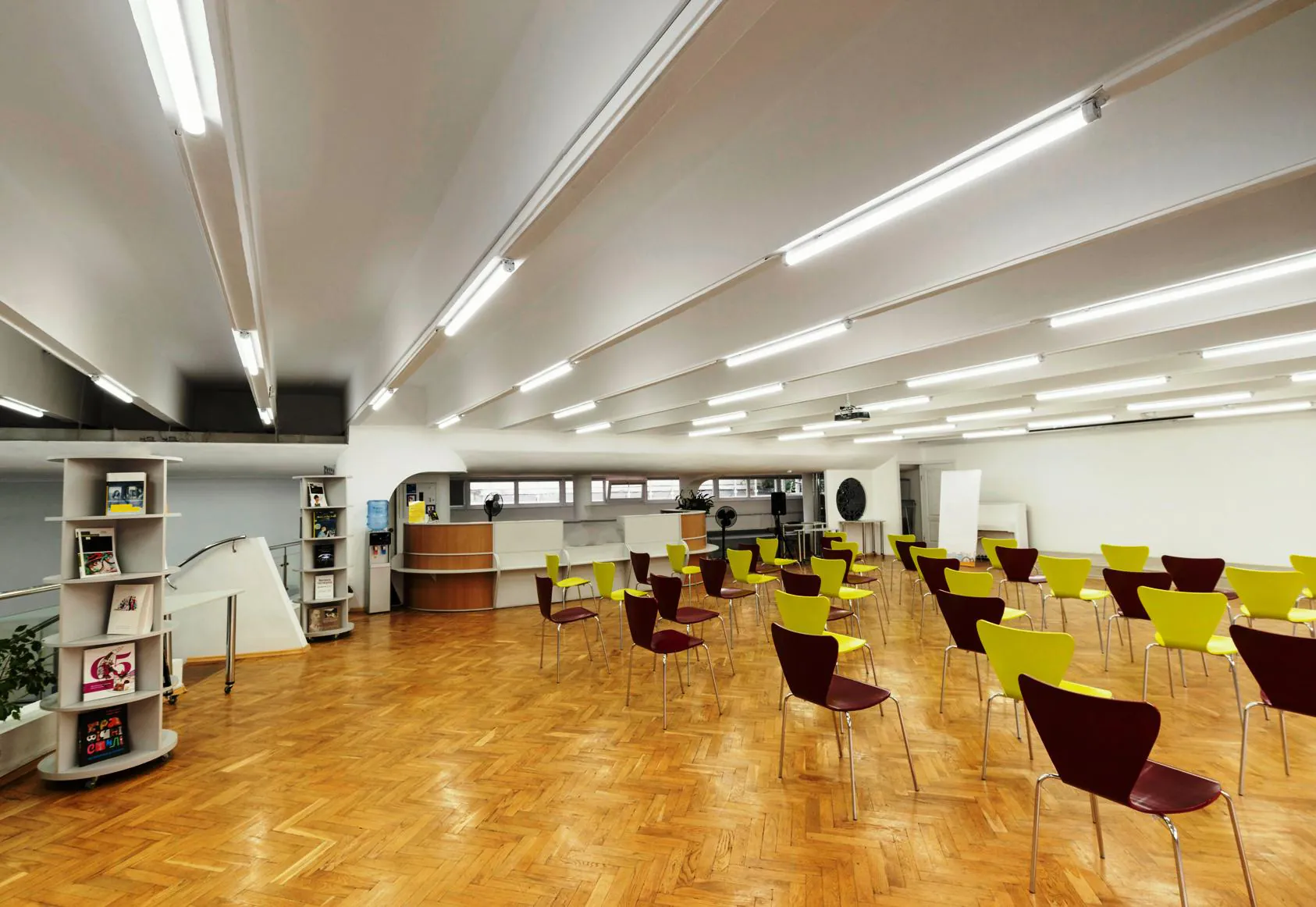Benefits of Smart Lighting in Schools
Lighting in schools can make a difference for students. It may seem like lighting is only there for the purpose of providing illumination, but the advantages of proper lighting can go beyond its primary function. Something as simple as lighting can affect learning ability, mood, safety, and more. The truth is that good lighting is necessary for the welfare of the students, and smart lighting can take these schools and learning institutions to another level.
How can lighting in a school setting help students focus on learning?
Lighting, in general, plays a crucial role in creating a conducive learning environment in schools. Proper lighting can help students focus on learning by improving their mood, alertness, and overall well-being.
Here are some ways or aspects in which lighting can positively impact students' ability to concentrate and learn:
- Natural Lighting: Incorporating natural light into classrooms is ideal. Sunlight provides a full spectrum of color that is easy on the eyes and helps regulate circadian rhythms. It can boost mood, reduce stress, and increase alertness.
- Task Lighting: Classrooms that have adequate task lighting, such as overhead lights, will provide even illumination for specific tasks throughout the space. Harsh or flickering lights can cause distractions and discomfort.
- Color Temperature: The color temperature of lighting in schools can also impact students. Cooler, bluish-white light can increase alertness, which is suitable for morning classes or activities that require focus. Warmer, yellowish-white light, on the other hand, can create a more relaxed atmosphere, suitable for calming activities or late afternoon lessons.
- Lighting Controls: Dimmer switches or adjustable lighting controls allow teachers to customize the lighting based on the activity. Brighter lights can be used for lectures and reading, while dimmer lighting can create a cozy atmosphere for group discussions or relaxation.
- Glare Reduction: Reduced glare on computer screens, whiteboards, and other reflective surfaces also has a positive influence. Proper window treatments or anti-glare coatings on windows can help reduce glare and eye strain for students and teachers alike.
- Uniform Illumination: Evenly distributed lighting across the classroom can increase focus and comfort. Dark spots and shadows can create visual discomfort and make it difficult for students to read or focus on tasks.
- Color Psychology with Lighting: The color of the walls and furniture in combination with lighting can also change things inside the classroom. Certain colors can enhance focus and concentration, while others may be distracting. Choose calming colors for areas where concentration is essential.
- Energy-Efficient Lighting: Energy-efficient lighting solutions, such as LED bulbs, can reduce energy consumption and maintenance costs while providing consistent and quality illumination for students and staff.
- Lighting Zones: Different lighting zones within the classroom can accommodate various activities for the students. For instance, adjustable lighting near reading nooks or project areas can be controlled separately from general classroom lighting.
- Dynamic Lighting: In some cases, dynamic lighting systems that mimic natural light patterns throughout the day can be beneficial as well. These systems can help regulate students' circadian rhythms and enhance alertness during specific learning periods.
A good lighting condition matters in an educational setting. It can significantly improve students' ability to focus on learning, enhance their well-being, and create a more engaging educational environment.
Smart lighting, of course, is a good way to harness all the lighting elements and impacts mentioned above. More and more institutions are installing smart lighting in schools and other educational settings, and all for good reasons.
What are the benefits of smart lighting in schools?
Smart lighting systems offer several benefits when implemented in schools. They contribute to energy efficiency, cost savings, and more. They also improve the overall learning environment by helping the learners focus and digest any knowledge being imparted to them.
Here are some of the advantages of using smart lighting in educational settings:
Energy Efficiency
Smart lighting systems are designed to be energy-efficient. They can automatically adjust light levels based on occupancy, natural light availability, and time of day. This ensures that lights are only on when and where they are needed. This results in reduced energy consumption and lower utility bills for schools.
In Sweden, Kattegatt High School, with digital and automated lighting systems, saves at least 30% energy compared to manually controlled lighting. With smart lighting, they are able to preserve energy and reduce the chances of light pollution.
Cost Savings
By optimizing energy use and reducing maintenance costs associated with frequent bulb replacements, smart lighting in schools can lead to significant cost savings over time. In the United Kingdom, LED smart bulbs can reduce energy bills by £35 each year. Schools can allocate this kind of savings to other educational needs.
Customizable Lighting
Smart lighting allows for precise control over lighting levels, color temperature, and lighting schedules. Teachers can adjust the lighting to suit different activities, such as lectures, group work, presentations, relaxation, and recreation. This creates an ideal learning environment for students.
Occupancy Sensors
Motion sensors and occupancy sensors integrated into smart lighting systems can detect when rooms are unoccupied and automatically turn off lights to save energy. When someone enters the room, the lights can be turned on or adjusted to a comfortable level.
Daylight Harvesting
Smart lighting systems can incorporate daylight harvesting technology, which adjusts artificial lighting levels based on the amount of natural light entering a room. This ensures consistent lighting conditions while minimizing energy use during sunny days.
Remote Control and Access
With smart lighting, school staff or administrators can control the lighting system remotely through a centralized control platform or mobile app. This feature is convenient for scheduling and monitoring lighting in multiple classrooms and areas within the school.
Enhanced Security
Smart lighting systems can be integrated with a school’s security systems to provide additional safety benefits. Lights can be programmed to flash or illuminate specific areas during emergencies, aiding evacuation procedures.
Data Collection and Analysis
Smart lighting systems can gather data on energy usage, occupancy patterns, and lighting preferences. This data can be used by school administrators to identify further opportunities for energy savings and optimize lighting schedules.
Longer Lifespan
LED lights, which are commonly used in smart lighting systems, have a longer lifespan than traditional lighting sources. Depending on the type of LED bulb, they can last between 10,000 and 50,000 hours. This reduces the frequency of bulb replacements and maintenance efforts, saving time and resources for schools.
Sustainability
Implementing smart lighting aligns with sustainability goals and reduces a school's carbon footprint. Lower energy consumption and reduced greenhouse gas emissions contribute to a more eco-friendly learning institution.
Humber College in Toronto, Canada installed a smart lighting system to support their aggressive sustainability goals. By their estimates, they have achieved a total savings of 70% in lighting energy. Their Building NX is also the first retrofit to achieve Zero Carbon Building Design Certification by the Canada Green Building Council (CaGBC). This is a clear example of how smart lighting in schools can achieve eco-friendly results with technology.
Improved Learning Environment
Properly designed and controlled lighting can create a more comfortable and conducive learning environment. The ability to adjust lighting levels and color temperature can positively affect students' focus, mood, and overall well-being, enhancing the learning experience.
Future-Proofing
Smart lighting systems are scalable and adaptable. As technology evolves, schools can easily integrate new features or sensors into the existing infrastructure, ensuring that their lighting system always remains up to date.
There are various smart lighting solutions available nowadays that schools can take advantage of. An example would be SOLUM Retail Lights by SOLUM Group. Although initially made for retail settings, these SOLUM smart lighting technology can easily be transformed into lighting for educational settings.
These SOLUM lights are equipped with modern LED lighting technology with remote control capabilities, customizable lighting options for optimized lighting, a long lifespan, aesthetic illumination design for an engaging and inviting atmosphere, easy installation and maintenance, and of course, energy efficiency capabilities.
Want to harness the benefits of smart lighting for yourself or your institution? Talk to SOLUM experts today to get started.











